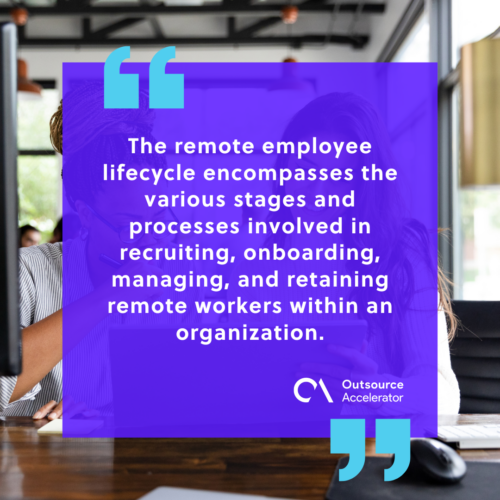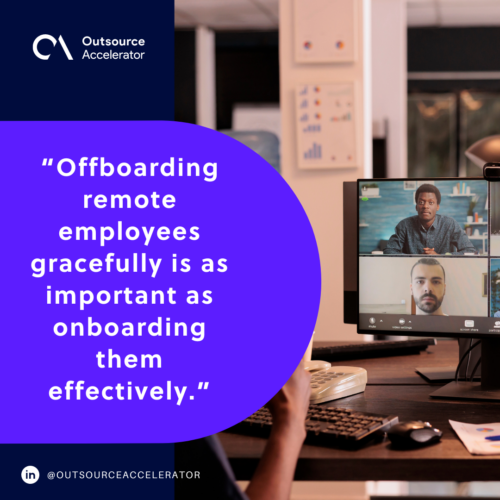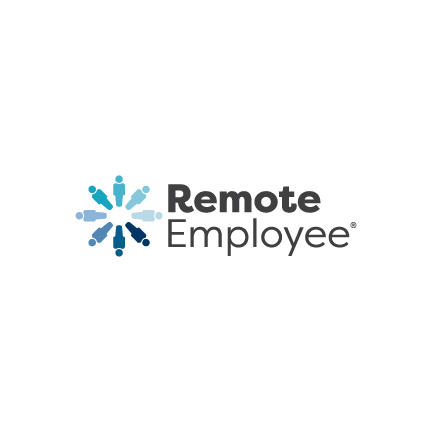7 vital stages for an effortless remote employee lifecycle

7 essential steps for a seamless remote employee lifecycle
In an era marked by digital transformation and evolving workplace dynamics, remote work has shifted from a fringe benefit to a mainstream necessity.
As businesses embrace the flexibility and efficiency of virtual work environments, effectively managing remote employee lifecycle has become increasingly vital for organizational success.
In this article, we’ll explore the intricacies of each stage of the remote employee lifecycle. As Remote Employee’s CEO quotes, “Investing in your team’s ongoing development is a smart move for any business looking to stay ahead of the game.”
Let’s define and learn ways to improve the remote employee lifecycle.
What is a remote employee lifecycle?
The remote employee lifecycle encompasses the various stages and processes involved in recruiting, onboarding, managing, and retaining remote workers within an organization.
This lifecycle mirrors the traditional employee lifecycle but is adapted to the unique challenges and opportunities presented by remote work arrangements.
Businesses should prioritize the lifecycle of remote employees because it directly impacts productivity, engagement, and retention in a distributed work environment.
A 2023 survey by FlexJobs involving 5,600 remote professionals found that 96% of respondents firmly believe that remote or hybrid work setups are most beneficial for their mental health.
By effectively managing each stage, from recruitment to retention, organizations can:
- Ensure seamless integration
- Optimize performance
- Foster a positive remote work culture
- Attract and retain top remote talent
Doing it right will lead to enhanced business outcomes and competitive advantage in an increasingly remote-first world.

7 steps of remote employee lifecycle
These steps in the remote employee lifecycle serve as a guide for the journey of remote workers within an organization. Each stage is crucial in ensuring the success and satisfaction of virtual staff, from recruitment to offboarding.
Let’s explore every step in detail:
1. Recruitment
Recruitment involves sourcing, screening, and selecting candidates for remote positions.
Craft clear job descriptions tailored for remote work and utilize remote-friendly recruitment platforms. Employers must also assess the candidates’ suitability for remote roles based on their:
- Communication skills
- Self-motivation
- Ability to work autonomously
FlairHR reports that 52% of recruiters’ major concern is improving the caliber of recruits. Incorporating virtual staff and emphasizing the remote employee lifecycle allows companies to hire seasoned global talent with a work-life balance.
2. Onboarding
According to Paychex’s study, over 36% of remote employees find onboarding procedures confusing.
Effective onboarding must introduce remote employees to the company culture, policies, tools, and workflows, setting the foundation for their success.
It includes providing access to necessary resources, scheduling virtual orientation sessions, assigning mentors or buddies, and outlining expectations.
Including viable onboarding strategies in your remote employee lifecycle can help remote hires feel welcomed and equipped for their roles.
3. Communication
Clear and consistent communication is essential for remote teams to collaborate effectively. Statista’s 2023 survey revealed that difficulty in communication and collaboration are among the primary struggles of 8% of respondents.
When it comes to fostering a cut above remote employee lifecycle, employers should:
- Establish communication channels and protocols
- Leverage video conferencing tools for meetings
- Encourage regular check-ins
They must foster an environment where remote employees feel comfortable sharing ideas, seeking clarification, and raising concerns.
4. Collaboration
To facilitate collaboration among remote employees, companies need to create opportunities for team interaction, project collaboration, and knowledge sharing.
They can achieve this by utilizing collaborative platforms, implementing project management tools, and organizing virtual team-building activities.
By promoting a collaborative work culture, companies help foster teamwork and camaraderie among remote team members.
5. Performance management
Remote performance management involves:
- Setting clear goals and expectations
- Providing regular feedback and coaching
- Assessing remote employees’ performance based on measurable outcomes
The management should establish key performance indicators (KPIs), conduct regular performance evaluations, and offer opportunities for skill development.
It’s also important to recognize and reward remote employees’ contributions to maintain motivation and accountability.
6. Support and well-being
Supporting the well-being of remote employees is crucial for their productivity, engagement, and satisfaction.
Offer resources and initiatives to support mental health and work-life balance. Provide access to ergonomic equipment, promote self-care practices, and create a work environment where remote employees feel valued, respected, and supported.
7. Offboarding
Offboarding remote employees gracefully is as important as onboarding them effectively.
Employers must:
- Conduct exit interviews to gather feedback
- Ensure a smooth transition of responsibilities
- Revoke access to company systems and data
- Express appreciation for the departing employee’s contributions, and
Maintaining positive relationships can help reengage them as boomerang employees or brand advocates in the future.

Hire seasoned virtual workers through Remote Employee
Tapping into a global talent pool allows businesses to access a diverse range of skills and expertise, enhancing innovation and problem-solving capabilities.
Remote workers often demonstrate higher levels of productivity and job satisfaction, leading to improved business outcomes.
By leveraging Remote Employee, businesses can seamlessly connect with top-tier remote talent worldwide, gaining a competitive edge in the rapidly evolving market.
Take the first step towards building a high-performing remote team by exploring Remote Employee’s services today!







 Independent
Independent




